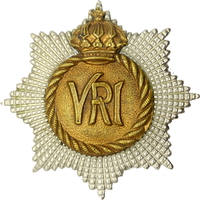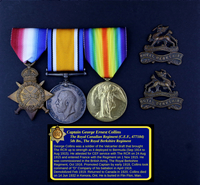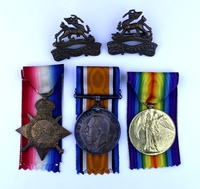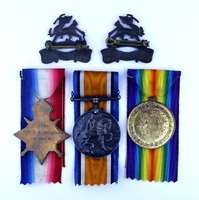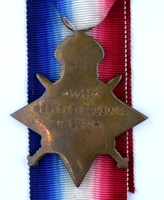
Captain George Ernest Collins
The Royal Canadian Regiment (C.E.F., 477184)
5th Bn., The Royal Berkshire Regiment
By: Capt (ret'd) Michael M. O'Leary, CD, The RCR
George Ernest Collins was born in Kenilworth, Warwickshire, England, on 29 Sep 1890. Born to parents Walter and Clara Jane (nee Bourne), both originally from Birmingham, George was the youngest of six surviving children. Father Walter was recorded in the UK censuses as an estate agent and an auctioneer. George emigrated to Canada in March of 1908, making the trans-Atlantic journey with his brother Arthur who had previously emigrated in 1906 but returned to visit in 1908. On arrival, the brothers declared their intended destination was Lloydminster, Saskatchewan. Three years later, the 1911 Canadian census shows them as farmers in the Alberta District of Victoria.
Although his file does not indicate which Militia unit draft Collins arrived in Valcartier with in August or September 1914, he was one of the volunteers selected to proceed to Bermuda in order to bring The Royal Canadian Regiment up to wartime strength. His medical examination form completed in Bermuda noted that his service "reckons from 5th Sept. 1914" although he may have been on a unit payroll before this date.
A surviving, but unattributed (due to a lost cover), officer's diary in the regimental museum of The RCR, describes the arrival of the Valcartier Draft at Halifax, N.S., as the Regiment prepared to sail for Bermuda. The east coast city was the Regiment's home station in the decade before the First World War.
"On 5th [Sep 1914] orders were received for the battalion to stand by for embarkation on 9th. The establishment on embarkation was not to exceed 1030 and 36 married families. Attached officers were allowed to volunteer so long as the total number of officers did not exceed thirty. A Medical Officer and Paymaster were allowed.
"The establishment was brought up by drafting 400 volunteers from 1st Contingent at Valcartier Camp. Two thousand men volunteered, 400 selected, embarked in S.S. Canada at Quebec and arrived at Halifax on 9th under Capt Russell L.S.H. (R.C.)
"This draft consisted of raw recruits for the most part and were not properly clothed or equipped, some being in their Militia uniforms, some in red, some even in plainclothes."
On 11 Sep 1914, The Royal Canadian Regiment sailed for Bermuda where they would serve for a year on garrison duty. The Regiment relieved the 2nd Battalion, Lincolnshire Regiment, which sailed immediately for England.
The soldiers of the reinforcement draft from Valcartier were medically examined and then taken on the strength of the Regiment. Collins officially joined The RCR at Bermuda on 28 Oct 1914 and was given the regimental number 16220.
On 12 Aug 1915, The RCR was relieved in turn by the arrival of the 38th Overseas Battalion from Canada. The RCR returned to Halifax for a stay of only a week. During this time, the Regiment was re-attested for overseas service. Although The RCR had just spent a year in Bermuda, there were concerns regarding the applicability of the soldiers' Permanent Force enlistments for a wartime deployment. This was, perhaps, prompted by the idea that a man on a P.F. three-year engagement could choose not to re-engage and the Government would be obligated to bring him home. Enlistment in the C.E.F., on the other hand, was for the "Duration of War." Accordingly, the soldiers of The RCR were re-attested, signing C.E.F. attestation papers in August 1915 before sailing for Europe.
George Collins attested for service in the Canadian Expeditionary Force (C.E.F.) with The RCR at Halifax, N.S., on 24 Aug 1915. A 24-year-old farmer, Collins was described on his attestation paper as 5 feet 7 inches tall, weighing 133 pounds, with a 36-inch chest, a fair complexion, blue eyes, and brown hair. He had a single tattoo, a Union Jack on his right arm. His religious denomination was Church of England. Collins identified his father, H. Collins, of The Woodlands, Clavenden, Warwickshire, Eng., as his next of kin.
The RCR sailed from Halifax on 26 Aug 1915 aboard the S.S. Caledonian, the same ship that had brought them home from Bermuda. Disembarking at Plymouth, England, on 6 Sep 1915, the Regiment went to Shorncliffe for training.
Collins would receive a new C.E.F. service number on 28 Sep 1915 to replace the regimental number he received on enlisting. While serving in the C.E.F., his service number would be 477184. Since the Regiment received its C.E.F. numbers while at full strength and not as they were recruited, it had the interesting effect that the soldiers of the Regiment at the time were renumbered in alphabetical order.
On 2 Oct 1915, Collins was admitted to the Tent Hospital, St. Martin's Plains, Shorncliffe. He was diagnosed with gonorrhoea and would remain under medical supervision for over three weeks. Pay documents in his service record show that he received his full pay for the month, apparently the mandatory forfeiture of half a soldier's daily pay while hospitalized for venereal disease that occurred later in the war was not yet invoked.
After a week in hospital, on 9 Oct 1915, Collins was transferred from "B" Company to the Regiment's Base Company which held men not assigned to the line companies. This lasted until he was discharged from hospital on 27 Oct 1915 and simultaneously posted back to "B" Company.
The RCR crossed the English Channel on 1 Nov 1915, entering the theatre of war at Boulogne, France, as a battalion of the 7th Canadian Infantry Brigade, 3rd Canadian Division. During November and December of 1915 the Regiment prepared for service in the trenches, with companies rotating in the lines for training and a period of providing working parties before entering the line as a battalion at the end of December. The first months of 1916 saw the Regiment in the steady rotation through front line trenches, support trenches, and reserve positions that was the fundamental experience of the infantry in the Great War.
Collins was granted nine days leave of absence from 21 Mar 1916. This would be hos only time away from the unit until the fall of 1916.
The activities of The RCR during the war are summarized in the unit's "Battle Bar Document" (which was prepared after the war by the Militia Department in anticipation of the possibility of clasps for the British War Medal). From the end of December 1915 until 6 Sep 1916, the document details unit activities for 216 days. Of these:
- 68 days were spent in the Forward Line of Trenches (16 tours of duty at the front, usually in four-day blocks)
- 42 days were spent in Brigade Reserve
- 43 days were spent in Divisional Reserve
- 65 days were spent in Corps Reserve
The Regiment's Battle Honours through the summer of 1916 encapsulate the actions for which Collins was with the battalion:
- Local Operations, 1916. (Previous to the Allied Offensive)
- Mount Sorrel; 2-13 June 1916
- Operations on the Somme. (1 July – 18 November, 1916)
- Somme, 1916; 1 July – 18 November 1916
- Pozieres Ridge; 23 July – 3 September 1916
- Flers-Courcelette; 15-22 September 1916
On 4 Oct 1916, George Collins was transferred to the Canadian Training Depot at Shorncliffe, Eng. He was returned to England for the purpose of being discharged from the Canadian Expeditionary Force in order to accept a commission as an officer in the British Army. On his Proceeding on Discharge form, Collins' rank was recorded as Lance Corporal.
Collins transfer to the C.T.D. may have only been on paper for the purposes of his discharge. There is some confusion in the dates recorded in his service record regarding this change of unit and exactly when he reported as an officer of the Royal Berkshire Regiment. Despite this messy paper trail, Lance Corporal George Collins received a temporary commission in the Imperial Army and became Second Lieutenant George Ernest Collins, 5th (Service) Battalion, Royal Berkshire Regiment.
The War Diary of the 5th Bn, Royal Berkshire Regiment, is less ambiguous. The battalion's War Diary entry for 4 Oct 1916 reads:
"1916-10-04; 5th Royal Berkshire
"Location France, Bernafay Wood
"2Lt G.E. COLLINS joined for duty. Casualties:- 1 o.r. Killed in action."
There is a webpage dedicated to The Royal Berkshire Regiment on the website of The Rifles, Berkshire and Wiltshire Museum (thewardrobe.org.uk). Excerpts summarizing the First World War service of the 5th Battalion during each year of the war. For late 1916, a single brief sentence provides:
"The winter of 1916 was spent in and out of the trenches and training."
The paragraph summarizing the 5th Berks' activities of 1917 provides the following:
"The winter of 1917 was spent in and out of the trenches and training. They engaged in a short raid on the 17th March which was modestly successful. On the 9th April they moved out from Arras through a network of tunnels and distinguished themselves once more at Battery Valley where they captured many German guns, even managing to turn some of them on the fleeing Germans. The summer of 1917 was spent mainly in and around Arras but there were no major actions. They arrived at Peronne on 15th November to prepare for the Battle of Cambrai which was launched 20th November. They achieved all their objectives despite their tanks suffering breakdowns but lost 6 officers and 161 Other Ranks out of a starting tally of 17 officers and 590 Other Ranks. The German counter-attack came on the 30th November and they were forced to retire. Their German opponents later commented on the quality of the greatcoats and the ample supply of food which the 5th had been obliged to leave behind. The Germans were most appreciative of their windfall. By the time the battle concluded the 5th had lost 8 officers and 295 Other ranks. They went into Reserve for the winter and spent Christmas day at Merville."
Collins is named in the pages of the Berkshire War Diary three times in 1917. On the first occasion, in March, he commands a raiding party element:
"1917-03-17; 5th Royal Berkshire
"France, Arras
"A raid was carried out on the German trenches at 7a.m. by a party of 10 officers and 200 other ranks. O.C. Raid Major J.S, SHARP 2nd in Command Lt W.C. ADAMS. Objective:- Enemy Front line from G.30.b.3.65 to G.30.b.4.0.. Support line from G.30.b.45.70 to G.30.b.65.30. The raiding party was divided into 6 parties, 3 for Front and 3 for Support line, Right Centre and Left. These parties were commanded by Lt. G.P. DEBONO, Lt J.M. READY, 2Lt M.B. BEATTIE, 2Lt G.E. COLLINS, 2Lt L.P.B. BARTLETT, 2Lt B.H.A. FELLOWES, 2Lt T. ROWELL, 2Lt A. MAYBURY. All parties reached their objectives. Three gaps had been successfully cut, and Bangalore torpedoes only had to by used by the right party. The left party was held up for a short time by M.G. fire, but this M.G. was dealt with by the Centre Party. Opposition in the trenches was not serious. All the Germans in the sector were killed or taken prisoner, and all dugouts were destroyed with stokes bombs. The parties returned at zero +25 minutes. Up to that time casualties had been very slight, only involving 2Lt B.H.A FELLOWES wounded going over and one o.r. wounded near enemy front line. Returning the party had to come back through a heavy barrage which caused serious casualties. Major J.S. SHARP was killed by a shell when only 10 yards from our parapet. Total results of the operation were that 2 machine guns and 6 prisoners was captured, about 120 Germans were Killed. Enemy's front and support line on front of 300 yards were thoroughly searched. Total Casualties:- Killed:- Major J.S. SHARP and 6 other ranks. Wounded:- 2Lt B.H.A. FELLOWES and 28 o.r. Missing believed Killed, 1 o.r. missing. Congratulations were sent to the Battalion by the Divisional Commander and the Corps Commander on the result of the raid."
In October 1917, Collins was promoted to the rank of Lieutenant:
"1917-10-25; 5th Royal Berkshire
"France, Front Line System, E. of Monchy
"The following badges of rank were approved. CAPTAIN J.L. CARR [to] Major; 2Lt G.E. COLLINS [to] LT. 1 other rank was killed. Draft of 5 other ranks joined."
In November 1917, while no reason for his being assigned away from the battalion is provided, he rejoins the unit in the front lines:
"1917-11-25; 5th Royal Berkshire
"France, Villiers Guislain
"25th - 29th New line consolidated. Battalion remained in Front system and experienced a very quiet time. Casualties were Nil till 29th Inst. when 4 o.r. were wounded. Following details joined on night of 29th Lt. G.E. Collins, 2Lt F.C.R. Hill, Lt H. SCHOFIELD, 2Lt F.A.I. WYKES, 2Lt E. JONES and 2Lt C.W. ADCOCK with 84 other ranks."
The 5th Bn, Royal Berkshire Regiment remained busy through 1918, the regimental museum's summary provides the following summary:
"They went into Reserve for the winter of 1918 around Béthune but had to move south rapidly when the German Spring Offensive began on the 21st March. However despite coming under occasional attack their role was primarily defensive and they were able to return to Reserve on the 29th March. They came under attack at Bouzincourt on the 5th April but it was beaten off. The 5th joined up with the Anson Battalion of the Royal Naval Division on the 24th May to launch an attack at Hamel. They captured a number of prisoners and guns but lost 14 dead with 73 wounded and 19 missing, mainly a reflection of the inexperience of the newly drafted Reinforcements. By the 30th June they were back to full strength of 719 and ready to join in the final defeat of the Germans. After that the advance was in full flight with engagements at Meaulte on the 22nd August, at Carnoy 26th August, Nurlu 5th September, Epehy 17th September and Tetard Wood 19th September. They were moved to Arras on the 5th October and saw their final engagement at the Canal de l'Escau on the 28th. When the Armistice came on the 11th November the 5th were at Vieux Cond and then retired to winter quarters at Erre near Valenciennes. Demobilization began on the 1st Jan 1919 and Colours were presented on the 14th February 1919. The remnant of the battalion left France on the 15th June and they had a Civic Reception at Reading on the 18th. Demobilization was completed immediately afterwards and the Battalion disbanded."
Collins appears in the unit War Diary once in 1918. The entry has him returning from Brigade Staff, and also holding new rank:
"1918-04-14; 5th Royal Berkshire
"France, Mirvaux
" 14th - 15th Training continued. Capt G.E. COLLINS rejoined from 35th Bde Staff and assumed command of 'D' Coy. Following decorations awarded by Corps Commander for gallantry on April 27th. Military Cross:- 2Lt T.P. MEYRICK. Bar to Military Medal:- 12003 Cpl Mc ALLISTER R. Military Medal:- 11714 Pte JACKSON C."
Captain Collins would make his last appearance in the War Diary in early 1919.
"1919-02-08; 5th Royal Berkshire
"France, Erre
"Training and Train Guards at SOMAIN. 35 O.R's Demobilized. Captain G.E. Collins Demobilized."
Collins arrived back in Canada on 16 Aug 1920 aboard the steamer Chignecto en roue from Bermuda and British Guyana. Docking at St John, N.B., his trade was listed as "overseer" and his intended occupation in Canada was "insurance agent." Collin's intended place of residence was noted as Kenora, Ontario, where he would join his brother Arthur.
Upon discharge from the B.E.F. and return to Canada, Collins was entitled to a War Service Gratuity of $100 for his service in the C.E.F. This was paid to him by cheque in January, 1921.
On 2 Jul 1924, Collins married Hilda Kelson Pittman at Kenora. Newfoundland-born, 24-year-old Hilda was living in Kenora with her parents, the family having moved there about 1908. Hilda appears in the 1921 census as a school teacher working in the village of Pelly, MacKenzie, Saskatchewan. The couple would have two children, Kelson (b. 1925) and Ray (b. tbc).
Collins and his young family lived in Flin Flon, Manitoba, for a few years while he worked for the Metropolitan Life Company. They returned to Kenora during the spring of 1932 due to Collins' poor health.
George Collins died on 14 Jun 1932 at the Kenora General Hospital. His place of residence recorded on his Ontario Certificate of Registration of Death is Flin Flon, Man., and his occupation is listed as Insurance Agent. On his registration of death, the cause is listed as haematemesis (i.e., vomiting blood), a contributory cause is also listed, "cancer of stomach".
An obituary notice published in the Kenora Miner and News on 15 Jun 1932 provided the following details:
"Death of G.E. Collins
"The death took place Tuesday afternoon of George Ernest Collins, after an illness extending over a year. The late G.E. Collins enlisted and went overseas from Edmonton in 1915 and after the war he came here, making his home with his brother at Norman. He resided here up to four years ago when he left for Flin Flon in the interests of the Metropolitan Life Co. About a month ago he decided to return to Kenora thinking that the change would be beneficial but without effect, as his constitution had been undermined by the war services, having been gassed and also suffered from Malaria overseas. He was highly esteemed by a large circle of friends for his kindly disposition and thoughtfulness and general sympathy will ho out to his widow and two small children, Kelson and Ray. The funeral service will be held at St. Alban's Pro-Cathedral Thursday afternoon at 2.30 with interment in Lake of the Woods Cemetery."
While it seems unlikely that Collins contracted malaria while serving in the Great War, its source may be in the year and a half between demobilization and return to Canada when he arrived on a steamer from Bermuda and British Guyana.
George was buried in the Lake of the Woods Cemetery, Kenora, on 16 Jun 1932. Hilda survived him another 51 years, she stayed in the area and died in 1983 and is buried beside George.
Pro Patria
Visit a randomly selected page in The O'Leary Collection (or reload for another choice):
- The O'Leary Collection; Medals of The Royal Canadian Regiment.
- Researching Canadian Soldiers of the First World War
- Researching The Royal Canadian Regiment
- The RCR in the First World War
- Badges of The RCR
- The Senior Subaltern
- The Minute Book (blog)
- Rogue Papers
- Tactical Primers
- The Regimental Library
- Battle Honours
- Perpetuation of the CEF
- A Miscellany
- Quotes
- The Frontenac Times
- Site Map
QUICK LINKS
The O'Leary Collection—Medals of The Royal Canadian Regiment
Newest additions:
![]()
![]() SB-12725 Private Henry "Hank" Ard
SB-12725 Private Henry "Hank" Ard ![]()
WIA at Hill 187, Died of Wounds in Japan
![]()
![]() 2355331 Lance Corporal Albert Lorking
2355331 Lance Corporal Albert Lorking
Wounded in action, later a War Amps representative.
![]()
![]() 4334 / 477996 Pte Isaac Hamilton Wilcox
4334 / 477996 Pte Isaac Hamilton Wilcox
Permanent Force, South Africa, and C.E.F.
![]()
![]() 477019 Private Harold Ashcroft
477019 Private Harold Ashcroft
Transferred to the Tunnelers.
![]()
![]() 734231 Private Clark D. Thompson
734231 Private Clark D. Thompson ![]()
The older Thompson brother, killed in action.
![]()
![]() 733849 Private Norman Parker Thompson
733849 Private Norman Parker Thompson
The younger Thompson brother; post-war service in the Special Guard.
![]()
![]()
![]() A305 / 400305 Private Andrew Walker
A305 / 400305 Private Andrew Walker ![]()
"Previously reported Wounded, now Killed in Action."
![]()
![]() 823298 Pte Thomas Patrick Steele, M.M.
823298 Pte Thomas Patrick Steele, M.M. ![]()
… for gallant conduct in the field …
![]()
![]() P13066 Sergeant Harold Thompson
P13066 Sergeant Harold Thompson
Instrumental Soloist for over 20 years of Canadian Army service.
![]()
![]() 9609 / 477728 Private Albert Edward Piper
9609 / 477728 Private Albert Edward Piper
"Arrived from England as a STOWAWAY …"
